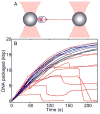Repulsive DNA-DNA interactions accelerate viral DNA packaging in phage Phi29
- PMID: 24996111
- PMCID: PMC5001848
- DOI: 10.1103/PhysRevLett.112.248101
Repulsive DNA-DNA interactions accelerate viral DNA packaging in phage Phi29
Abstract
We use optical tweezers to study the effect of attractive versus repulsive DNA-DNA interactions on motor-driven viral packaging. Screening of repulsive interactions accelerates packaging, but induction of attractive interactions by spermidine(3+) causes heterogeneous dynamics. Acceleration is observed in a fraction of complexes, but most exhibit slowing and stalling, suggesting that attractive interactions promote nonequilibrium DNA conformations that impede the motor. Thus, repulsive interactions facilitate packaging despite increasing the energy of the theoretical optimum spooled DNA conformation.
Figures




Similar articles
-
Nonequilibrium dynamics and ultraslow relaxation of confined DNA during viral packaging.Proc Natl Acad Sci U S A. 2014 Jun 10;111(23):8345-50. doi: 10.1073/pnas.1405109111. Epub 2014 May 27. Proc Natl Acad Sci U S A. 2014. PMID: 24912187 Free PMC article.
-
Single-Molecule Measurements of Motor-Driven Viral DNA Packaging in Bacteriophages Phi29, Lambda, and T4 with Optical Tweezers.Methods Mol Biol. 2018;1805:393-422. doi: 10.1007/978-1-4939-8556-2_20. Methods Mol Biol. 2018. PMID: 29971729
-
Single-molecule studies of viral DNA packaging.Curr Opin Virol. 2011 Aug;1(2):134-41. doi: 10.1016/j.coviro.2011.05.023. Epub 2011 Jul 1. Curr Opin Virol. 2011. PMID: 22440623 Free PMC article. Review.
-
Single-molecule studies of viral DNA packaging.Adv Exp Med Biol. 2012;726:549-84. doi: 10.1007/978-1-4614-0980-9_24. Adv Exp Med Biol. 2012. PMID: 22297530 Free PMC article. Review.
-
Methods for Studying Motor-Driven Viral DNA Packaging in Bacteriophages phi29, Lambda, and T4 via Single DNA Molecule Manipulation and Rapid Solution Exchange.Methods Mol Biol. 2025;2881:293-327. doi: 10.1007/978-1-0716-4280-1_15. Methods Mol Biol. 2025. PMID: 39704950
Cited by
-
Shapes of minimal-energy DNA ropes condensed in confinement.Sci Rep. 2016 Jul 1;6:29012. doi: 10.1038/srep29012. Sci Rep. 2016. PMID: 27364168 Free PMC article.
-
Nonequilibrium dynamics and ultraslow relaxation of confined DNA during viral packaging.Proc Natl Acad Sci U S A. 2014 Jun 10;111(23):8345-50. doi: 10.1073/pnas.1405109111. Epub 2014 May 27. Proc Natl Acad Sci U S A. 2014. PMID: 24912187 Free PMC article.
-
Phi29 Connector-DNA Interactions Govern DNA Crunching and Rotation, Supporting the Check-Valve Model.Biophys J. 2016 Jan 19;110(2):455-469. doi: 10.1016/j.bpj.2015.12.010. Biophys J. 2016. PMID: 26789768 Free PMC article.
-
Evidence that a catalytic glutamate and an 'Arginine Toggle' act in concert to mediate ATP hydrolysis and mechanochemical coupling in a viral DNA packaging motor.Nucleic Acids Res. 2019 Feb 20;47(3):1404-1415. doi: 10.1093/nar/gky1217. Nucleic Acids Res. 2019. PMID: 30541105 Free PMC article.
-
Continuity of states between the cholesteric → line hexatic transition and the condensation transition in DNA solutions.Sci Rep. 2014 Nov 5;4:6877. doi: 10.1038/srep06877. Sci Rep. 2014. PMID: 25371012 Free PMC article.
References
Publication types
MeSH terms
Substances
Grants and funding
LinkOut - more resources
Full Text Sources
Other Literature Sources
